Children MERCEDES-BENZ E-Class COUPE 2013 C207 Owner's Manual
[x] Cancel search | Manufacturer: MERCEDES-BENZ, Model Year: 2013, Model line: E-Class COUPE, Model: MERCEDES-BENZ E-Class COUPE 2013 C207Pages: 372, PDF Size: 12.69 MB
Page 8 of 372
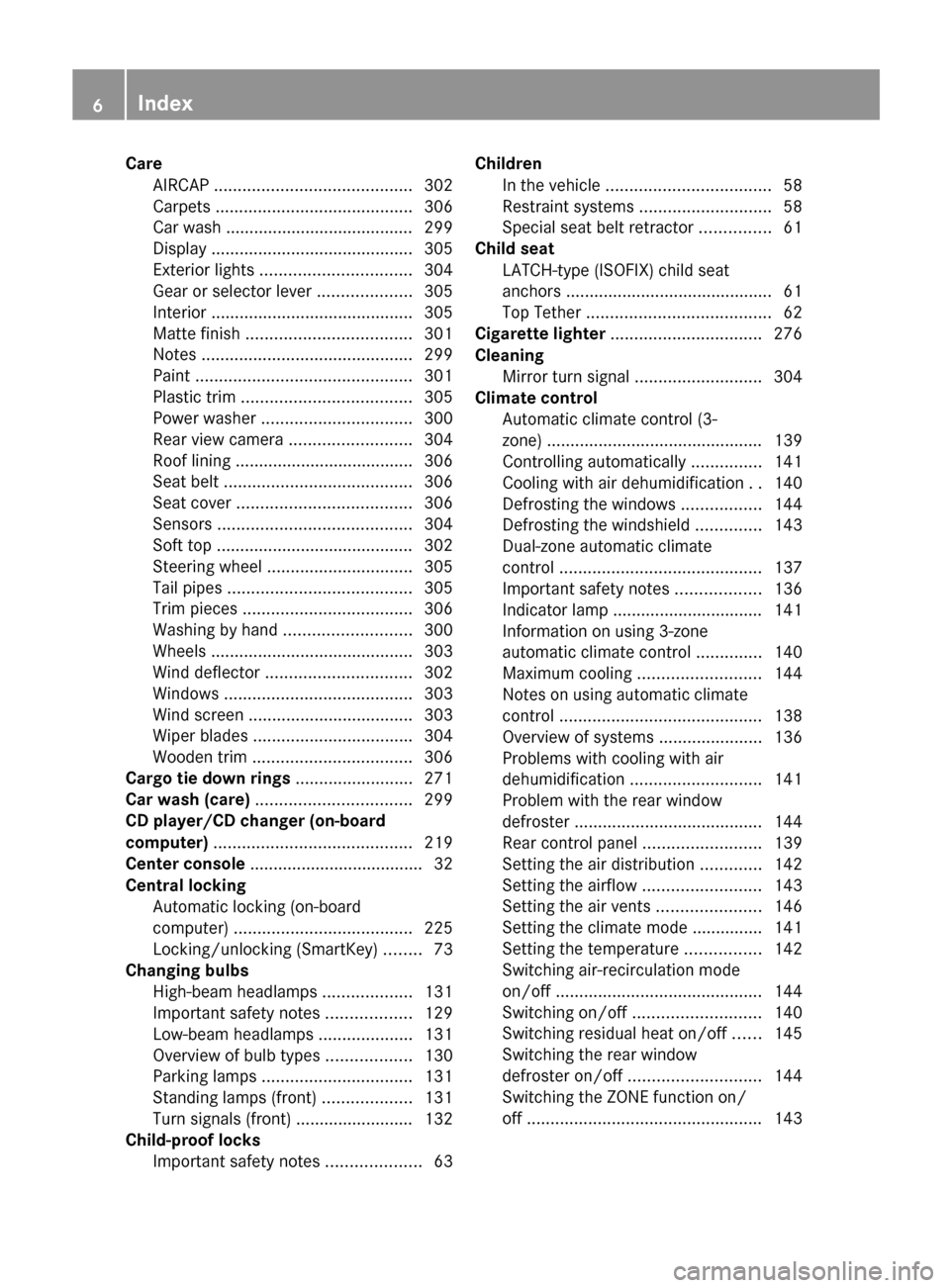
Care
AIRCAP .......................................... 302
Carpets .......................................... 306
Car wash
........................................ 299
Display ........................................... 305
Exterior lights ................................ 304
Gear or selector lever ....................305
Interior ........................................... 305
Matte finish ................................... 301
Notes ............................................. 299
Paint .............................................. 301
Plastic trim .................................... 305
Power washer ................................ 300
Rear view camera .......................... 304
Roof lining ...................................... 306
Seat belt ........................................ 306
Seat cover ..................................... 306
Sensors ......................................... 304
Soft top .......................................... 302
Steering wheel ............................... 305
Tail pipes ....................................... 305
Trim pieces .................................... 306
Washing by hand ........................... 300
Wheels ........................................... 303
Wind deflector ............................... 302
Windows ........................................ 303
Wind screen ................................... 303
Wiper blades .................................. 304
Wooden trim .................................. 306
Cargo tie down rings .........................271
Car wash (care) ................................. 299
CD player/CD changer (on-board
computer) .......................................... 219
Center console ..................................... 32
Central locking Automatic locking (on-board
computer) ...................................... 225
Locking/unlocking (SmartKey) ........ 73
Changing bulbs
High-beam headlamps ...................131
Important safety notes .................. 129
Low-beam headlamps .................... 131
Overview of bulb types ..................130
Parking lamps ................................ 131
Standing lamps (front) ...................131
Turn signals (front) ......................... 132
Child-proof locks
Important safety notes .................... 63Children
In the vehicle ................................... 58
Restraint systems ............................ 58
Special seat belt retractor ............... 61
Child seat
LATCH-type (ISOFIX) child seat
anchors ............................................ 61
Top Tether ....................................... 62
Cigarette lighter ................................ 276
Cleaning Mirror turn signal ........................... 304
Climate control
Automatic climate control (3-
zone) .............................................. 139
Controlling automatically
............... 141
Cooling with air dehumidification ..140
Defrosting the windows ................. 144
Defrosting the windshield .............. 143
Dual-zone automatic climate
control ........................................... 137
Important safety notes .................. 136
Indicator lamp ................................ 141
Information on using 3-zone
automatic climate control .............. 140
Maximum cooling .......................... 144
Notes on using automatic climate
control ........................................... 138
Overview of systems ......................136
Problems with cooling with air
dehumidification ............................ 141
Problem with the rear window
defroster ........................................ 144
Rear control panel .........................139
Setting the air distribution .............142
Setting the airflow ......................... 143
Setting the air vents ......................146
Setting the climate mode ............... 141
Setting the temperature ................ 142
Switching air-recirculation mode
on/off ............................................ 144
Switching on/off ........................... 140
Switching residual heat on/off ...... 145
Switching the rear window
defroster on/off ............................ 144
Switching the ZONE function on/
off .................................................. 1436
Index
Page 15 of 372
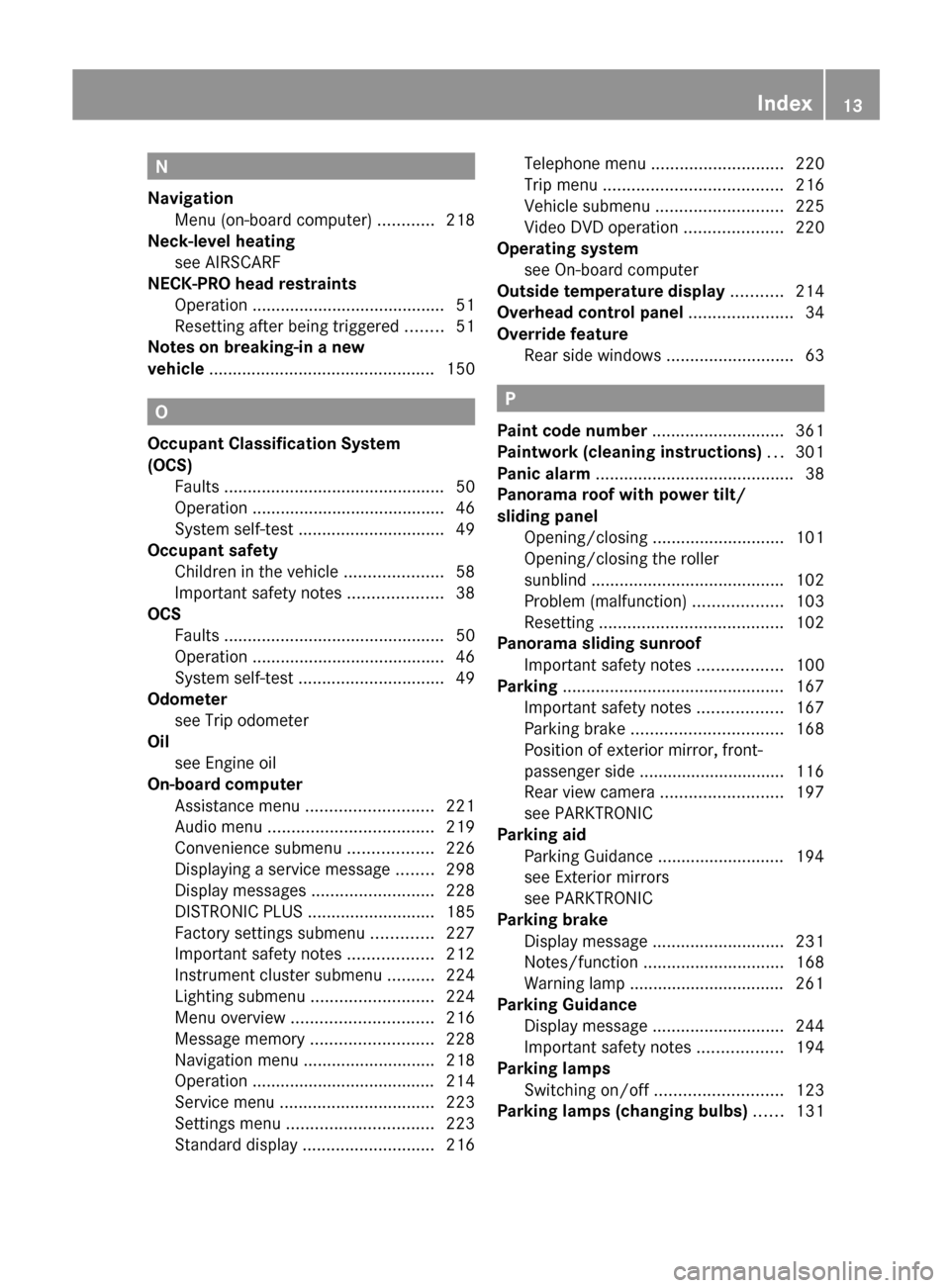
N
Navigation Menu (on-board computer) ............ 218
Neck-level heating
see AIRSCARF
NECK-PRO head restraints
Operation ......................................... 51
Resetting after being triggered ........ 51
Notes on breaking-in a new
vehicle ................................................ 150O
Occupant Classification System
(OCS) Faults ............................................... 50
Operation ......................................... 46
System self-test
............................... 49
Occupant safety
Children in the vehicle .....................58
Important safety notes .................... 38
OCS
Faults ............................................... 50
Operation ......................................... 46
System self-test ............................... 49
Odometer
see Trip odometer
Oil
see Engine oil
On-board computer
Assistance menu ........................... 221
Audio menu ................................... 219
Convenience submenu .................. 226
Displaying a service message ........ 298
Display messages ..........................228
DISTRONIC PLUS ........................... 185
Factory settings submenu ............. 227
Important safety notes .................. 212
Instrument cluster submenu ..........224
Lighting submenu .......................... 224
Menu overview .............................. 216
Message memory .......................... 228
Navigation menu ............................ 218
Operation ....................................... 214
Service menu ................................. 223
Settings menu ............................... 223
Standard display ............................ 216Telephone menu
............................ 220
Trip menu ...................................... 216
Vehicle submenu
........................... 225
Video DVD operation ..................... 220
Operating system
see On-board computer
Outside temperature display ...........214
Overhead control panel ......................34
Override feature Rear side windows ........................... 63 P
Paint code number ............................ 361
Paintwork (cleaning instructions) ...301
Panic alarm .......................................... 38
Panorama roof with power tilt/
sliding panel
Opening/closing ............................ 101
Opening/closing the roller
sunblind ......................................... 102
Problem (malfunction) ...................103
Resetting ....................................... 102
Panorama sliding sunroof
Important safety notes
..................100
Parking ............................................... 167
Important safety notes .................. 167
Parking brake ................................ 168
Position of exterior mirror, front-
passenger side ............................... 116
Rear view camera .......................... 197
see PARKTRONIC
Parking aid
Parking Guidance ........................... 194
see Exterior mirrors
see PARKTRONIC
Parking brake
Display message ............................ 231
Notes/function .............................. 168
Warning lamp ................................. 261
Parking Guidance
Display message ............................ 244
Important safety notes .................. 194
Parking lamps
Switching on/off ........................... 123
Parking lamps (changing bulbs) ......131 Index
13
Page 17 of 372
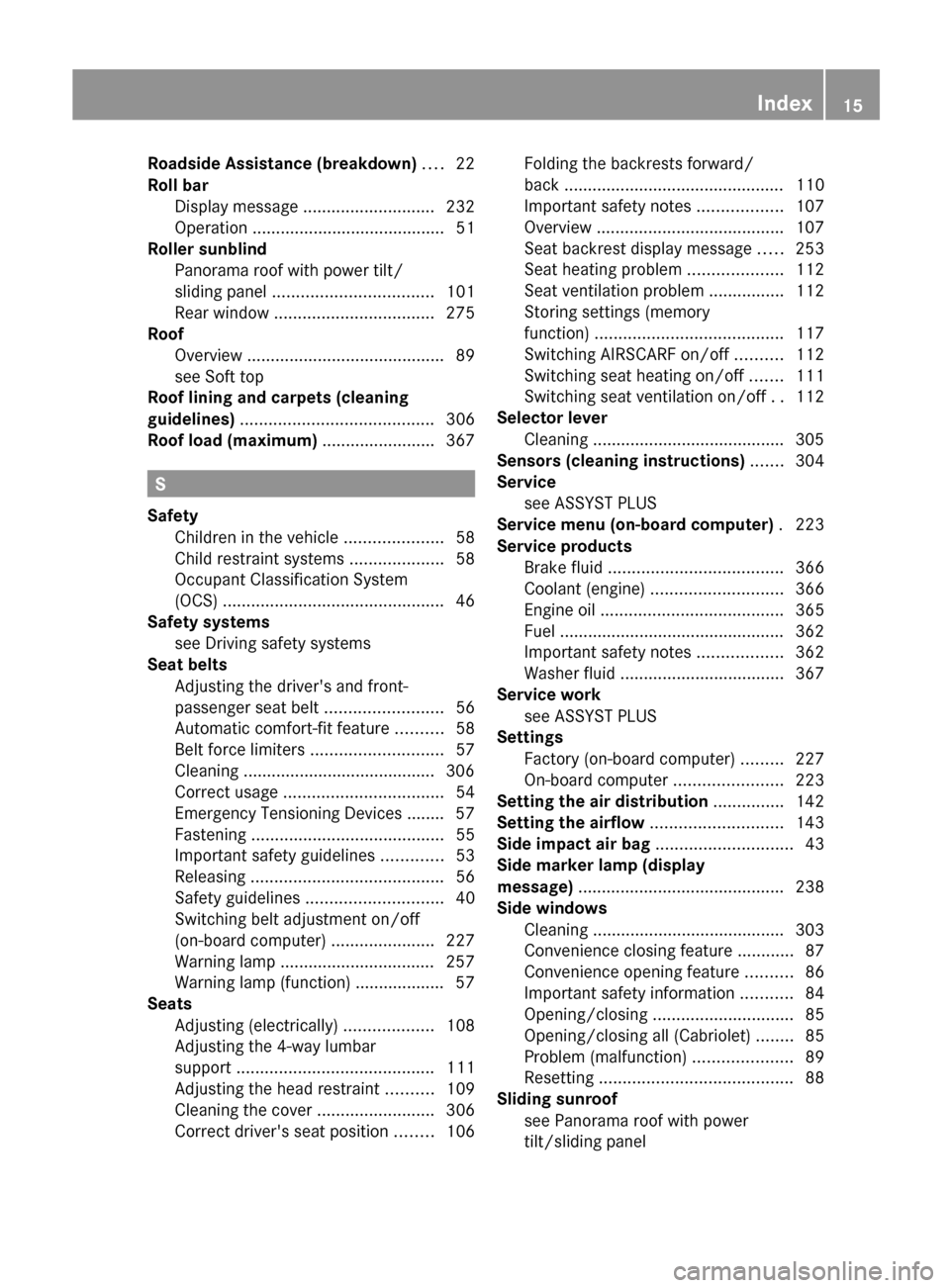
Roadside Assistance (breakdown)
....22
Roll bar Display message
............................ 232
Operation ......................................... 51
Roller sunblind
Panorama roof with power tilt/
sliding panel .................................. 101
Rear window .................................. 275
Roof
Overview .......................................... 89
see Soft top
Roof lining and carpets (cleaning
guidelines) ......................................... 306
Roof load (maximum) ........................367S
Safety Children in the vehicle .....................58
Child restraint systems ....................58
Occupant Classification System
(OCS) ............................................... 46
Safety systems
see Driving safety systems
Seat belts
Adjusting the driver's and front-
passenger seat belt .........................56
Automatic comfort-fit feature .......... 58
Belt force limiters ............................ 57
Cleaning ......................................... 306
Correct usage .................................. 54
Emergency Tensioning Devices ........ 57
Fastening ......................................... 55
Important safety guidelines .............53
Releasing ......................................... 56
Safety guidelines ............................. 40
Switching belt adjustment on/off
(on-board computer) ...................... 227
Warning lamp ................................. 257
Warning lamp (function) ................... 57
Seats
Adjusting (electrically) ...................108
Adjusting the 4-way lumbar
support .......................................... 111
Adjusting the head restraint .......... 109
Cleaning the cover ......................... 306
Correct driver's seat position ........ 106Folding the backrests forward/
back ...............................................
110
Important safety notes .................. 107
Overview ........................................ 107
Seat backrest display message .....253
Seat heating problem .................... 112
Seat ventilation problem ................ 112
Storing settings (memory
function) ........................................ 117
Switching AIRSCARF on/off ..........112
Switching seat heating on/off ....... 111
Switching seat ventilation on/off ..112
Selector lever
Cleaning ......................................... 305
Sensors (cleaning instructions) .......304
Service see ASSYST PLUS
Service menu (on-board computer) . 223
Service products Brake fluid ..................................... 366
Coolant (engine) ............................ 366
Engine oil ....................................... 365
Fuel ................................................ 362
Important safety notes .................. 362
Washer fluid ................................... 367
Service work
see ASSYST PLUS
Settings
Factory (on-board computer) ......... 227
On-board computer ....................... 223
Setting the air distribution ...............142
Setting the airflow ............................ 143
Side impact air bag ............................. 43
Side marker lamp (display
message) ............................................ 238
Side windows Cleaning ......................................... 303
Convenience closing feature ............ 87
Convenience opening feature .......... 86
Important safety information ........... 84
Opening/closing .............................. 85
Opening/closing all (Cabriolet) ........ 85
Problem (malfunction) .....................89
Resetting ......................................... 88
Sliding sunroof
see Panorama roof with power
tilt/sliding panel Index
15
Page 39 of 372
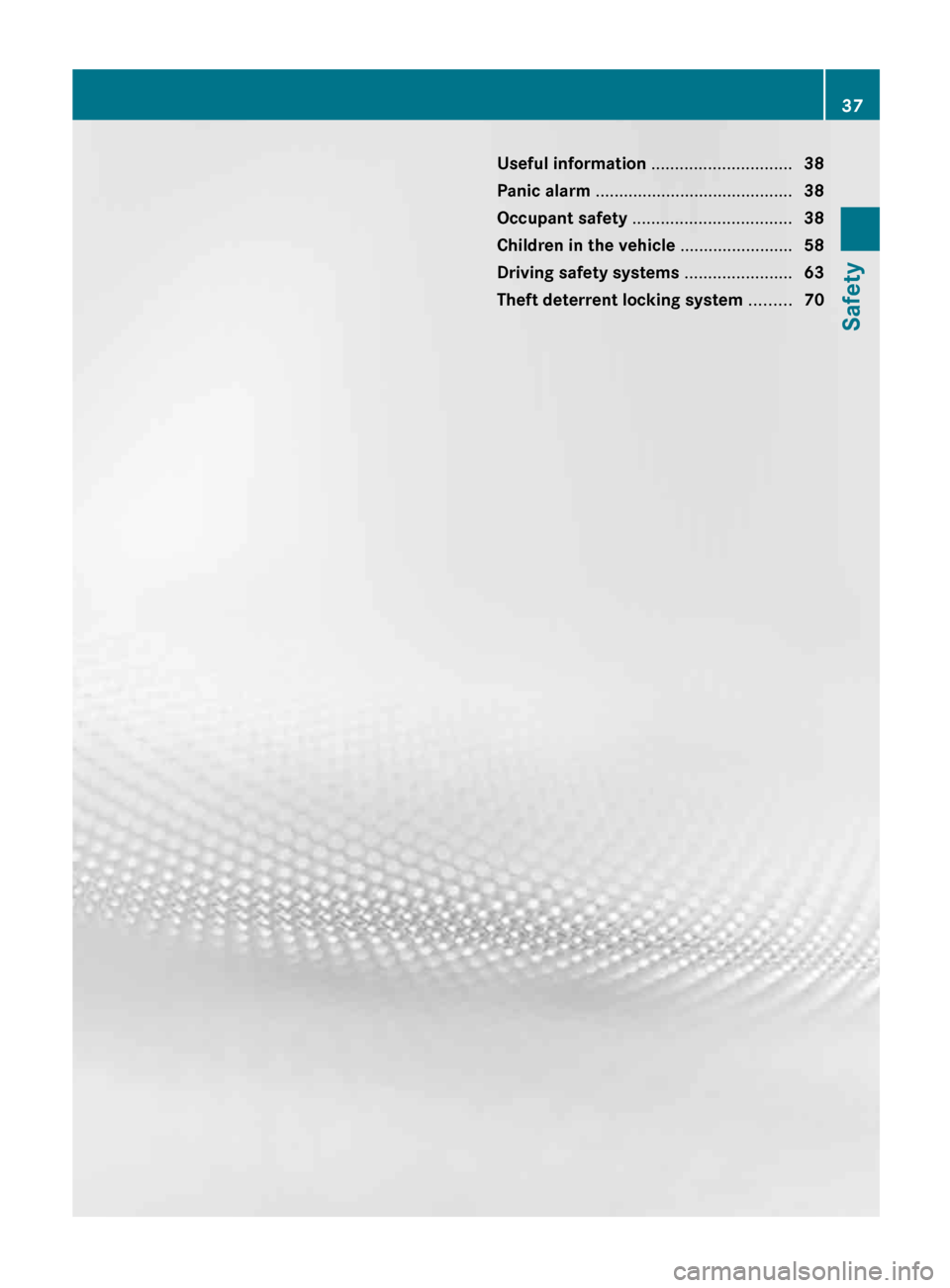
Useful information ..............................
38
Panic alarm .......................................... 38
Occupant safety .................................. 38
Children in the vehicle ........................58
Driving safety systems ....................... 63
Theft deterrent locking system ......... 70 37Safety
Page 41 of 372

tamper with electronic components or their
software.
In this section, you will learn the most
important facts about the restraint system
components of the vehicle.
The restraint system consists of:
R seat belts
R child restraint systems
R LATCH-type (ISOFIX) child seat anchors
Additional protection is provided by:
R SRS (Supplemental Restraint System)
R NECK-PRO head restraints
R PRE-SAFE ®
R Cabriolet: roll bar
R air bag system components with:
-PASSENGER
AIR BAG OFF indicator lamp
- front-passenger seat with Occupant
Classification System (OCS)
The different air bag systems work
independently of each other. The protective
functions of the system work in conjunction
with each other. Not all air bags are deployed
in an accident.
i See "Children in the vehicle" for
information on infants and children
traveling with you in the vehicle restraint
systems for infants and children
(Y page 58). SRS (Supplemental Restraint System)
Introduction SRS consists of:
R
6 SRS warning lamp
R Air bags
R Air bag control unit with crash sensors
R Emergency Tensioning Devices
R Belt force limiters
SRS reduces the risk of occupants coming
into contact with the vehicle's interior in the
event of an accident. It can also reduce the effect of the forces to which occupants are
subjected during an accident.
SRS warning lamp
G
WARNING
The SRS self-check has detected a
malfunction if the 6 SRS indicator lamp:
R does not light up at all
R does not go out after approximately four
seconds after the engine is started
R lights
up after the engine is started or while
the vehicle is in motion
For your safety, Mercedes-Benz strongly
recommends that you have the system
checked as soon as possible at a qualified
specialist workshop. SRS may otherwise fail
to activate when it is needed in the event of
an accident, which could lead to serious or
fatal injuries. SRS might also be activated
unexpectedly and unnecessarily, which could
also result in injury.
In addition, work carried out improperly on
SRS may render SRS inoperative or cause
unintended air bag deployment. Work on the
SRS system should only be carried out by
qualified specialist personnel. Consult a
qualified specialist workshop.
If it is necessary to modify an air bag system
to accommodate a person with disabilities,
contact an authorized Mercedes-Benz Center
for details. USA only: for further information,
contact our Customer Assistance Center at
1-800-FOR-MERCedes (1-800-367-6372).
SRS functions are checked regularly when
you switch on the ignition and when the
engine is running. Therefore, malfunctions
can be detected in good time.
The 6 SRS warning lamp in the instrument
cluster lights up when the ignition is switched
on. It goes out no later than a few seconds
after the engine is started.
The SRS components are in operational
readiness when the SRS 6 indicator lamp
goes out while the engine is running. Occupant safety
39
Safety Z
Page 43 of 372
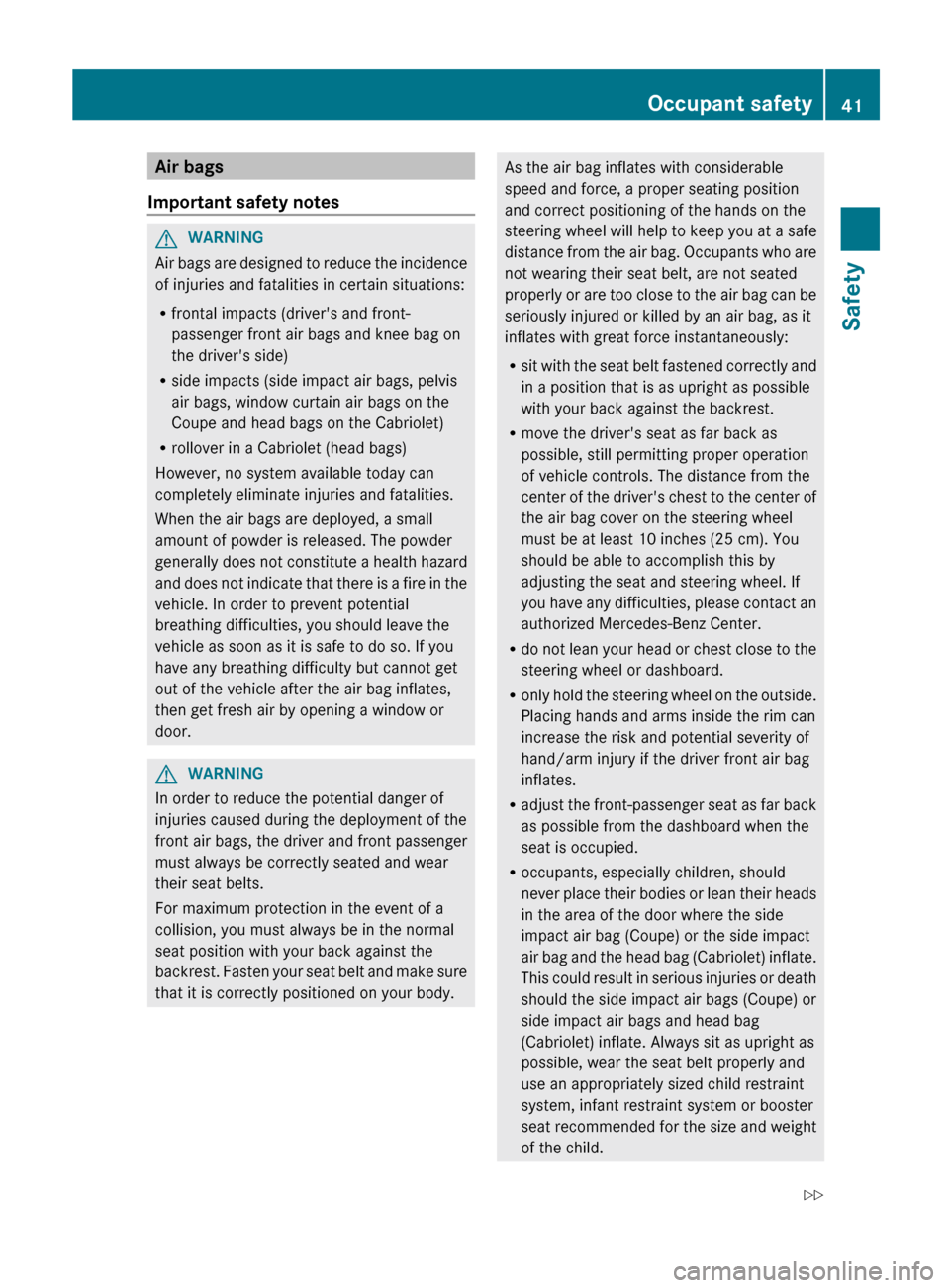
Air bags
Important safety notes G
WARNING
Air bags are designed to reduce the incidence
of injuries and fatalities in certain situations:
R frontal impacts (driver's and front-
passenger front air bags and knee bag on
the driver's side)
R side impacts (side impact air bags, pelvis
air bags, window curtain air bags on the
Coupe and head bags on the Cabriolet)
R rollover in a Cabriolet (head bags)
However, no system available today can
completely eliminate injuries and fatalities.
When the air bags are deployed, a small
amount of powder is released. The powder
generally
does not constitute a health hazard
and does not indicate that there is a fire in the
vehicle. In order to prevent potential
breathing difficulties, you should leave the
vehicle as soon as it is safe to do so. If you
have any breathing difficulty but cannot get
out of the vehicle after the air bag inflates,
then get fresh air by opening a window or
door. G
WARNING
In order to reduce the potential danger of
injuries caused during the deployment of the
front air bags, the driver and front passenger
must always be correctly seated and wear
their seat belts.
For maximum protection in the event of a
collision, you must always be in the normal
seat position with your back against the
backrest.
Fasten your seat belt and make sure
that it is correctly positioned on your body. As the air bag inflates with considerable
speed and force, a proper seating position
and correct positioning of the hands on the
steering
wheel will help to keep you at a safe
distance from the air bag. Occupants who are
not wearing their seat belt, are not seated
properly or are too close to the air bag can be
seriously injured or killed by an air bag, as it
inflates with great force instantaneously:
R sit with the seat belt fastened correctly and
in a position that is as upright as possible
with your back against the backrest.
R move the driver's seat as far back as
possible, still permitting proper operation
of vehicle controls. The distance from the
center of the driver's chest to the center of
the air bag cover on the steering wheel
must be at least 10 inches (25 cm). You
should be able to accomplish this by
adjusting the seat and steering wheel. If
you have any difficulties, please contact an
authorized Mercedes-Benz Center.
R do not lean your head or chest close to the
steering wheel or dashboard.
R only hold the steering wheel on the outside.
Placing hands and arms inside the rim can
increase the risk and potential severity of
hand/arm injury if the driver front air bag
inflates.
R adjust the front-passenger seat as far back
as possible from the dashboard when the
seat is occupied.
R occupants, especially children, should
never place their bodies or lean their heads
in the area of the door where the side
impact air bag (Coupe) or the side impact
air bag and the head bag (Cabriolet) inflate.
This could result in serious injuries or death
should the side impact air bags (Coupe) or
side impact air bags and head bag
(Cabriolet) inflate. Always sit as upright as
possible, wear the seat belt properly and
use an appropriately sized child restraint
system, infant restraint system or booster
seat recommended for the size and weight
of the child. Occupant safety
41
Safety
Z
Page 44 of 372
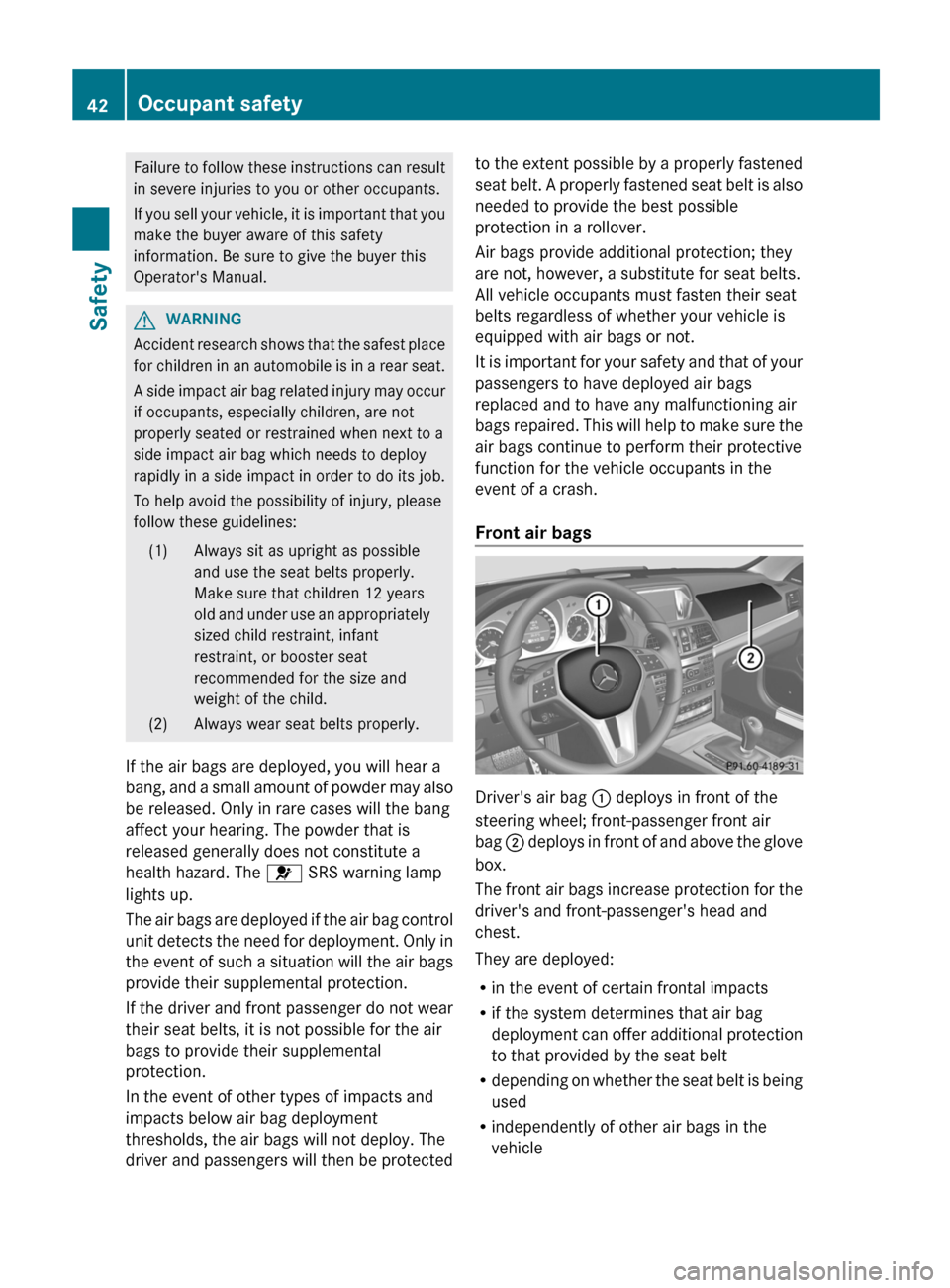
Failure to follow these instructions can result
in severe injuries to you or other occupants.
If
you sell your vehicle, it is important that you
make the buyer aware of this safety
information. Be sure to give the buyer this
Operator's Manual. G
WARNING
Accident research shows that the safest place
for
children in an automobile is in a rear seat.
A side impact air bag related injury may occur
if occupants, especially children, are not
properly seated or restrained when next to a
side impact air bag which needs to deploy
rapidly in a side impact in order to do its job.
To help avoid the possibility of injury, please
follow these guidelines:
(1) Always sit as upright as possible and use the seat belts properly.
Make sure that children 12 years
old
and under use an appropriately
sized child restraint, infant
restraint, or booster seat
recommended for the size and
weight of the child.
(2) Always wear seat belts properly.
If the air bags are deployed, you will hear a
bang,
and a small amount of powder may also
be released. Only in rare cases will the bang
affect your hearing. The powder that is
released generally does not constitute a
health hazard. The 6 SRS warning lamp
lights up.
The air bags are deployed if the air bag control
unit detects the need for deployment. Only in
the event of such a situation will the air bags
provide their supplemental protection.
If the driver and front passenger do not wear
their seat belts, it is not possible for the air
bags to provide their supplemental
protection.
In the event of other types of impacts and
impacts below air bag deployment
thresholds, the air bags will not deploy. The
driver and passengers will then be protected to the extent possible by a properly fastened
seat
belt. A properly fastened seat belt is also
needed to provide the best possible
protection in a rollover.
Air bags provide additional protection; they
are not, however, a substitute for seat belts.
All vehicle occupants must fasten their seat
belts regardless of whether your vehicle is
equipped with air bags or not.
It is important for your safety and that of your
passengers to have deployed air bags
replaced and to have any malfunctioning air
bags repaired. This will help to make sure the
air bags continue to perform their protective
function for the vehicle occupants in the
event of a crash.
Front air bags Driver's air bag
: deploys in front of the
steering wheel; front-passenger front air
bag ;
deploys in front of and above the glove
box.
The front air bags increase protection for the
driver's and front-passenger's head and
chest.
They are deployed:
R in the event of certain frontal impacts
R if the system determines that air bag
deployment can offer additional protection
to that provided by the seat belt
R depending on whether the seat belt is being
used
R independently of other air bags in the
vehicle42
Occupant safety
Safety
Page 49 of 372
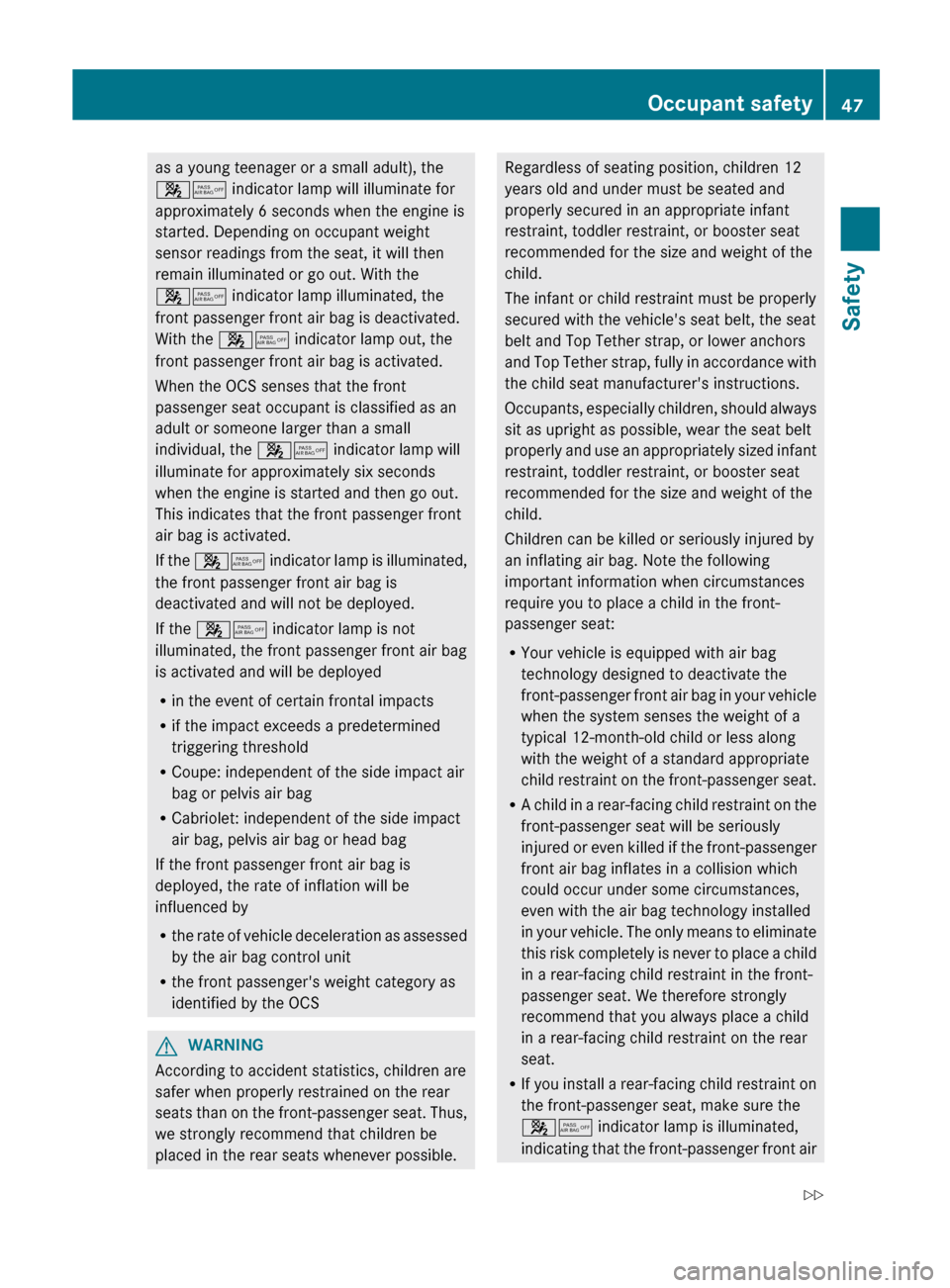
as a young teenager or a small adult), the
45 indicator lamp will illuminate for
approximately 6 seconds when the engine is
started. Depending on occupant weight
sensor readings from the seat, it will then
remain illuminated or go out. With the
45 indicator lamp illuminated, the
front passenger front air bag is deactivated.
With the 45 indicator lamp out, the
front passenger front air bag is activated.
When the OCS senses that the front
passenger seat occupant is classified as an
adult or someone larger than a small
individual, the
45 indicator lamp will
illuminate for approximately six seconds
when the engine is started and then go out.
This indicates that the front passenger front
air bag is activated.
If
the 45 indicator lamp is illuminated,
the front passenger front air bag is
deactivated and will not be deployed.
If the 45 indicator lamp is not
illuminated, the front passenger front air bag
is activated and will be deployed
R in the event of certain frontal impacts
R if the impact exceeds a predetermined
triggering threshold
R Coupe: independent of the side impact air
bag or pelvis air bag
R Cabriolet: independent of the side impact
air bag, pelvis air bag or head bag
If the front passenger front air bag is
deployed, the rate of inflation will be
influenced by
R the rate of vehicle deceleration as assessed
by the air bag control unit
R the front passenger's weight category as
identified by the OCS G
WARNING
According to accident statistics, children are
safer when properly restrained on the rear
seats
than on the front-passenger seat. Thus,
we strongly recommend that children be
placed in the rear seats whenever possible. Regardless of seating position, children 12
years old and under must be seated and
properly secured in an appropriate infant
restraint, toddler restraint, or booster seat
recommended for the size and weight of the
child.
The infant or child restraint must be properly
secured with the vehicle's seat belt, the seat
belt and Top Tether strap, or lower anchors
and
Top Tether strap, fully in accordance with
the child seat manufacturer's instructions.
Occupants, especially children, should always
sit as upright as possible, wear the seat belt
properly and use an appropriately sized infant
restraint, toddler restraint, or booster seat
recommended for the size and weight of the
child.
Children can be killed or seriously injured by
an inflating air bag. Note the following
important information when circumstances
require you to place a child in the front-
passenger seat:
R Your vehicle is equipped with air bag
technology designed to deactivate the
front-passenger front air bag in your vehicle
when the system senses the weight of a
typical 12-month-old child or less along
with the weight of a standard appropriate
child restraint on the front-passenger seat.
R A child in a rear-facing child restraint on the
front-passenger seat will be seriously
injured or even killed if the front-passenger
front air bag inflates in a collision which
could occur under some circumstances,
even with the air bag technology installed
in your vehicle. The only means to eliminate
this risk completely is never to place a child
in a rear-facing child restraint in the front-
passenger seat. We therefore strongly
recommend that you always place a child
in a rear-facing child restraint on the rear
seat.
R If you install a rear-facing child restraint on
the front-passenger seat, make sure the
45 indicator lamp is illuminated,
indicating that the front-passenger front air Occupant safety
47
Safety
Z
Page 50 of 372
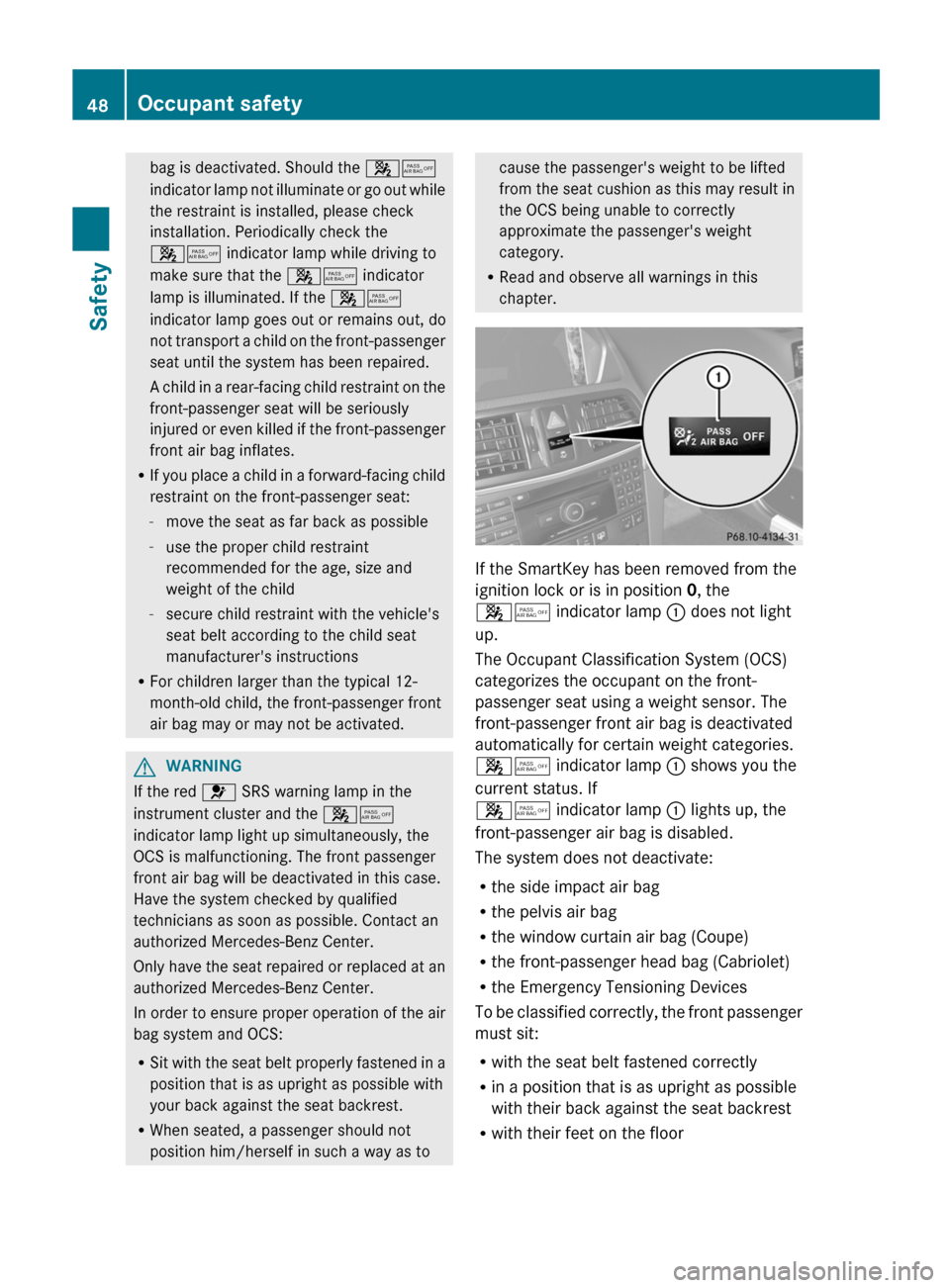
bag is deactivated. Should the
45
indicator lamp not illuminate or go out while
the restraint is installed, please check
installation. Periodically check the
45 indicator lamp while driving to
make sure that the 45 indicator
lamp is illuminated. If the 45
indicator lamp goes out or remains out, do
not transport a child on the front-passenger
seat until the system has been repaired.
A child in a rear-facing child restraint on the
front-passenger seat will be seriously
injured or even killed if the front-passenger
front air bag inflates.
R If you place a child in a forward-facing child
restraint on the front-passenger seat:
-move the seat as far back as possible
- use the proper child restraint
recommended for the age, size and
weight of the child
- secure child restraint with the vehicle's
seat belt according to the child seat
manufacturer's instructions
R For children larger than the typical 12-
month-old child, the front-passenger front
air bag may or may not be activated. G
WARNING
If the red 6 SRS warning lamp in the
instrument cluster and the 45
indicator lamp light up simultaneously, the
OCS is malfunctioning. The front passenger
front air bag will be deactivated in this case.
Have the system checked by qualified
technicians as soon as possible. Contact an
authorized Mercedes-Benz Center.
Only
have the seat repaired or replaced at an
authorized Mercedes-Benz Center.
In order to ensure proper operation of the air
bag system and OCS:
R Sit with the seat belt properly fastened in a
position that is as upright as possible with
your back against the seat backrest.
R When seated, a passenger should not
position him/herself in such a way as to cause the passenger's weight to be lifted
from
the seat cushion as this may result in
the OCS being unable to correctly
approximate the passenger's weight
category.
R Read and observe all warnings in this
chapter. If the SmartKey has been removed from the
ignition lock or is in position 0, the
45 indicator lamp
: does not light
up.
The Occupant Classification System (OCS)
categorizes the occupant on the front-
passenger seat using a weight sensor. The
front-passenger front air bag is deactivated
automatically for certain weight categories.
45 indicator lamp : shows you the
current status. If
45 indicator lamp : lights up, the
front-passenger air bag is disabled.
The system does not deactivate:
R the side impact air bag
R the pelvis air bag
R the window curtain air bag (Coupe)
R the front-passenger head bag (Cabriolet)
R the Emergency Tensioning Devices
To
be classified correctly, the front passenger
must sit:
R with the seat belt fastened correctly
R in a position that is as upright as possible
with their back against the seat backrest
R with their feet on the floor48
Occupant safety
Safety
Page 55 of 372
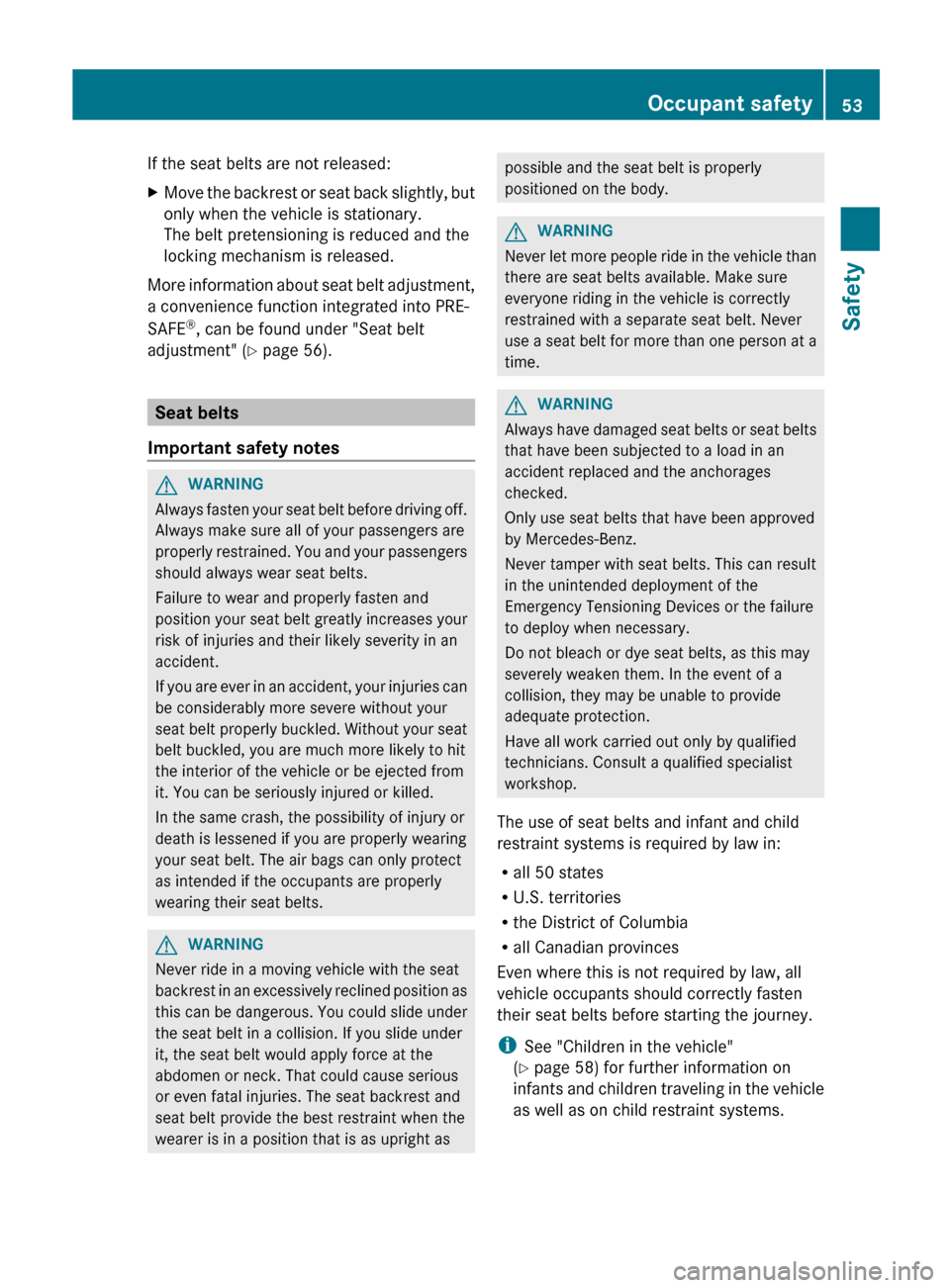
If the seat belts are not released:
X
Move the backrest or seat back slightly, but
only when the vehicle is stationary.
The belt pretensioning is reduced and the
locking mechanism is released.
More information about seat belt adjustment,
a convenience function integrated into PRE-
SAFE ®
, can be found under "Seat belt
adjustment" (Y page 56). Seat belts
Important safety notes G
WARNING
Always fasten your seat belt before driving off.
Always make sure all of your passengers are
properly
restrained. You and your passengers
should always wear seat belts.
Failure to wear and properly fasten and
position your seat belt greatly increases your
risk of injuries and their likely severity in an
accident.
If you are ever in an accident, your injuries can
be considerably more severe without your
seat belt properly buckled. Without your seat
belt buckled, you are much more likely to hit
the interior of the vehicle or be ejected from
it. You can be seriously injured or killed.
In the same crash, the possibility of injury or
death is lessened if you are properly wearing
your seat belt. The air bags can only protect
as intended if the occupants are properly
wearing their seat belts. G
WARNING
Never ride in a moving vehicle with the seat
backrest
in an excessively reclined position as
this can be dangerous. You could slide under
the seat belt in a collision. If you slide under
it, the seat belt would apply force at the
abdomen or neck. That could cause serious
or even fatal injuries. The seat backrest and
seat belt provide the best restraint when the
wearer is in a position that is as upright as possible and the seat belt is properly
positioned on the body.
G
WARNING
Never let more people ride in the vehicle than
there are seat belts available. Make sure
everyone riding in the vehicle is correctly
restrained with a separate seat belt. Never
use
a seat belt for more than one person at a
time. G
WARNING
Always have damaged seat belts or seat belts
that have been subjected to a load in an
accident replaced and the anchorages
checked.
Only use seat belts that have been approved
by Mercedes-Benz.
Never tamper with seat belts. This can result
in the unintended deployment of the
Emergency Tensioning Devices or the failure
to deploy when necessary.
Do not bleach or dye seat belts, as this may
severely weaken them. In the event of a
collision, they may be unable to provide
adequate protection.
Have all work carried out only by qualified
technicians. Consult a qualified specialist
workshop.
The use of seat belts and infant and child
restraint systems is required by law in:
R all 50 states
R U.S. territories
R the District of Columbia
R all Canadian provinces
Even where this is not required by law, all
vehicle occupants should correctly fasten
their seat belts before starting the journey.
i See "Children in the vehicle"
(Y page 58) for further information on
infants
and children traveling in the vehicle
as well as on child restraint systems. Occupant safety
53
Safety Z